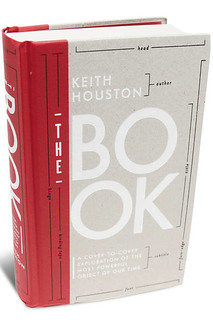
PREV ARTICLE
NEXT ARTICLE
FULL ISSUE
PREV FULL ISSUE
BOOK REVIEW: THE BOOK
This Wall Street Journal article from August 29, 2016 reviewed the new book on the history of the book, titled simply, The
Book. -Editor
Why are most printed books rectangular? One might imagine that it’s for ergonomic reasons—they’re easier to hold, carry and store. But according to Keith Houston, author of “The Book,” they have this shape “because cows, goats, and sheep are rectangular.” Two millennia ago, when the scribes of Pergamon in what’s now western Turkey stopped writing on papyrus scrolls and began to use sheets of parchment, they were creating a template for publishing—and a macabre one at that, since “a sheet of parchment is the end product of a bloody, protracted, and very physical process that begins with the death of a calf, lamb, or kid.” “The Book” abounds with similarly graphic insights as it traces the history of this numinous object, beginning with the Egyptians’ invention of papyrus 5,000 years ago. Mr. Houston, a Scottish software engineer based in Edinburgh, has previously published “Shady Characters” (2013), a guide to the punctuation marks and typographical oddities that intersperse our daily lives. There he revealed twin enthusiasms: for probing the hidden stories of everyday phenomena, such as the @ symbol that appears in every email we send, and for rescuing from oblivion such curios as the back-to-front question mark known as the point d’ironie, devised by the French poet Marcel Bernhardt in the 1890s. The same exuberance pervades “The Book”—and it needs to, for this is a volume crammed with technical information about matters that include binding techniques and the printing of devotional images as souvenirs for medieval pilgrims. There are nearly 70 dense pages of endnotes, and esoteric vocabulary swarms all around. The protective opening section of a roll of papyrus is a “protokollon”; the yellow pigment arsenic trisulfide is otherwise known as “orpiment”; a wrinkled piece of parchment is said to be “cockled”; and papermakers at one time employed a device called a “glazing hammer” for smoothing their wares. A chapter on bookbinding digresses into a discussion of the particularly odd-sounding “anthropodermic bibliopegy” (which involves books being bound in human skin). Mr. Houston is an eager, affable guide, and his detailed history is a welcome reminder that this “unrepentantly analog contraption” is one of the truly great pieces of technology. To read the complete article (subscription required), see:
To read the earlier E-Sylum article, see:

Wayne Homren, Editor The Numismatic Bibliomania Society is a non-profit organization promoting numismatic literature. See our web site at coinbooks.org. To submit items for publication in The E-Sylum, write to the Editor at this address: whomren@gmail.com To subscribe go to: https://my.binhost.com/lists/listinfo/esylum All Rights Reserved. NBS Home Page Contact the NBS webmaster 
|
